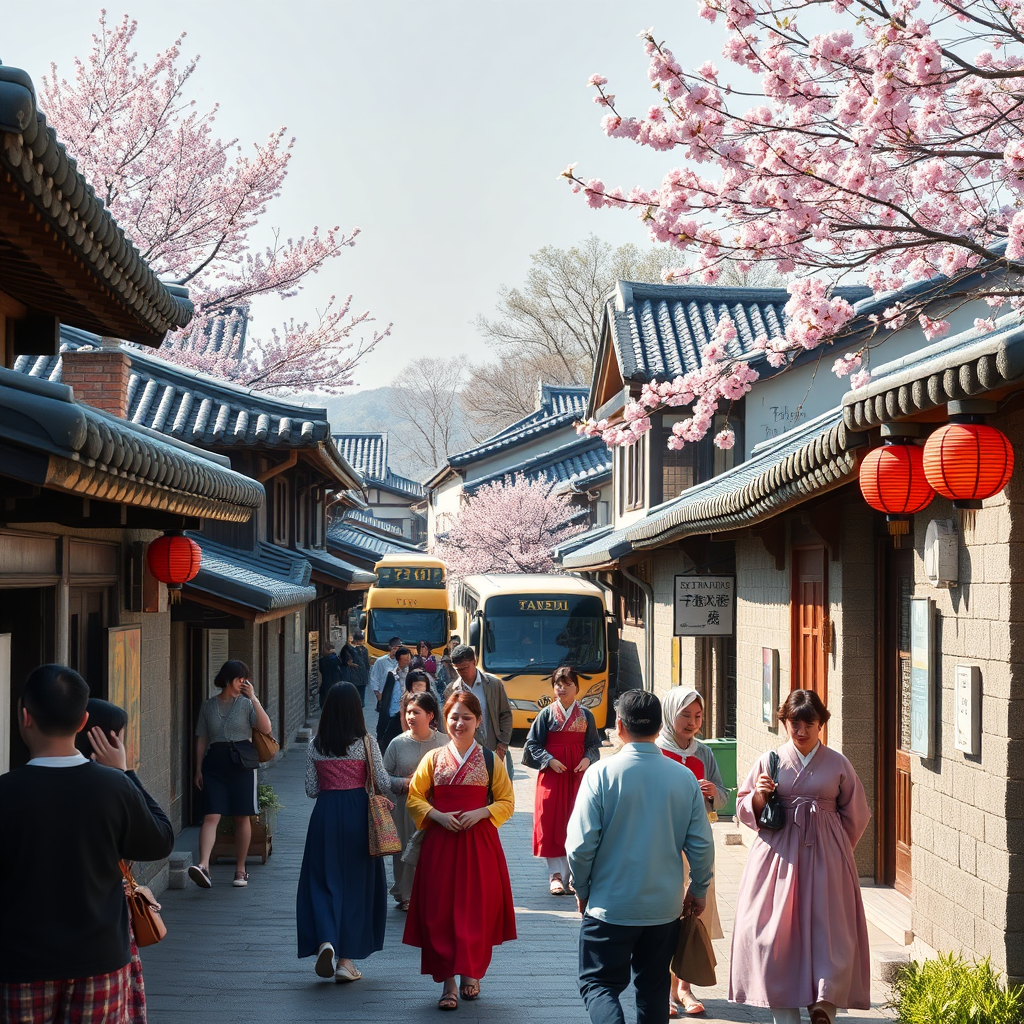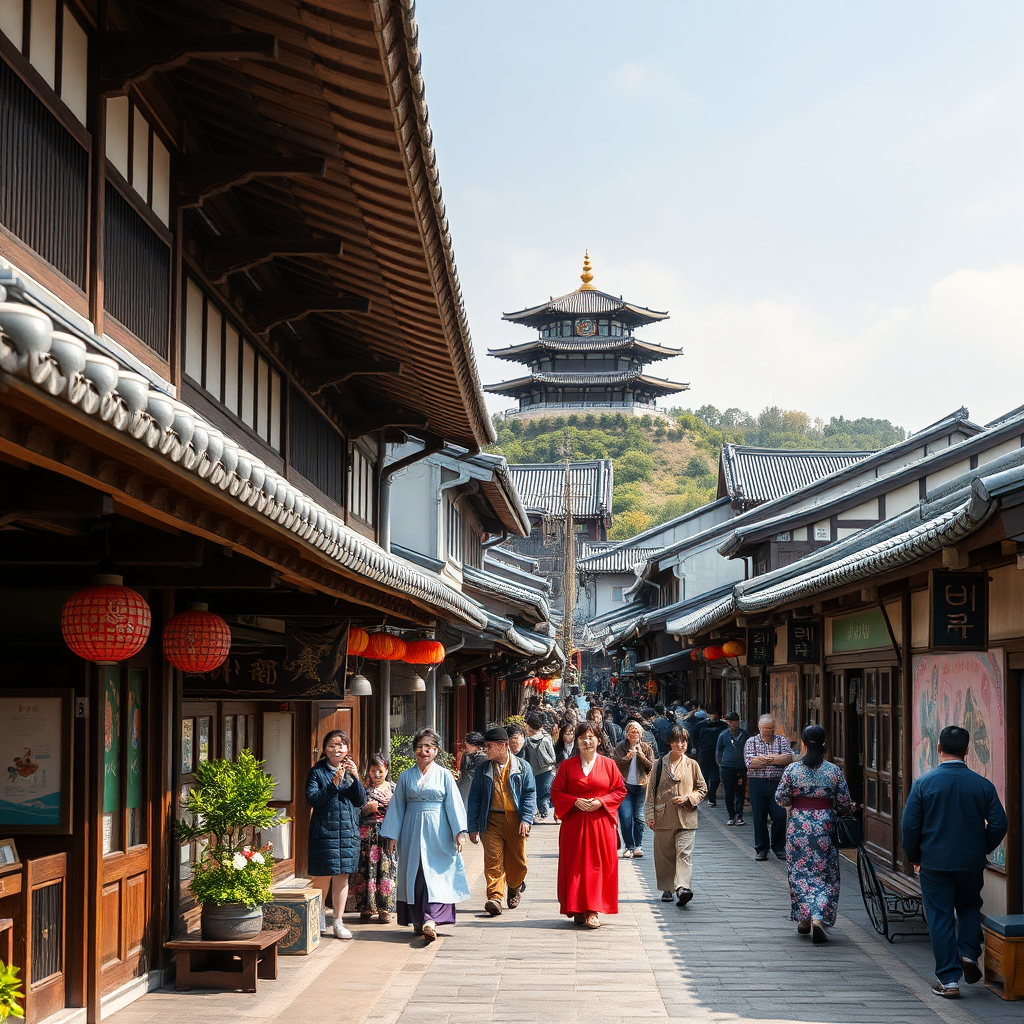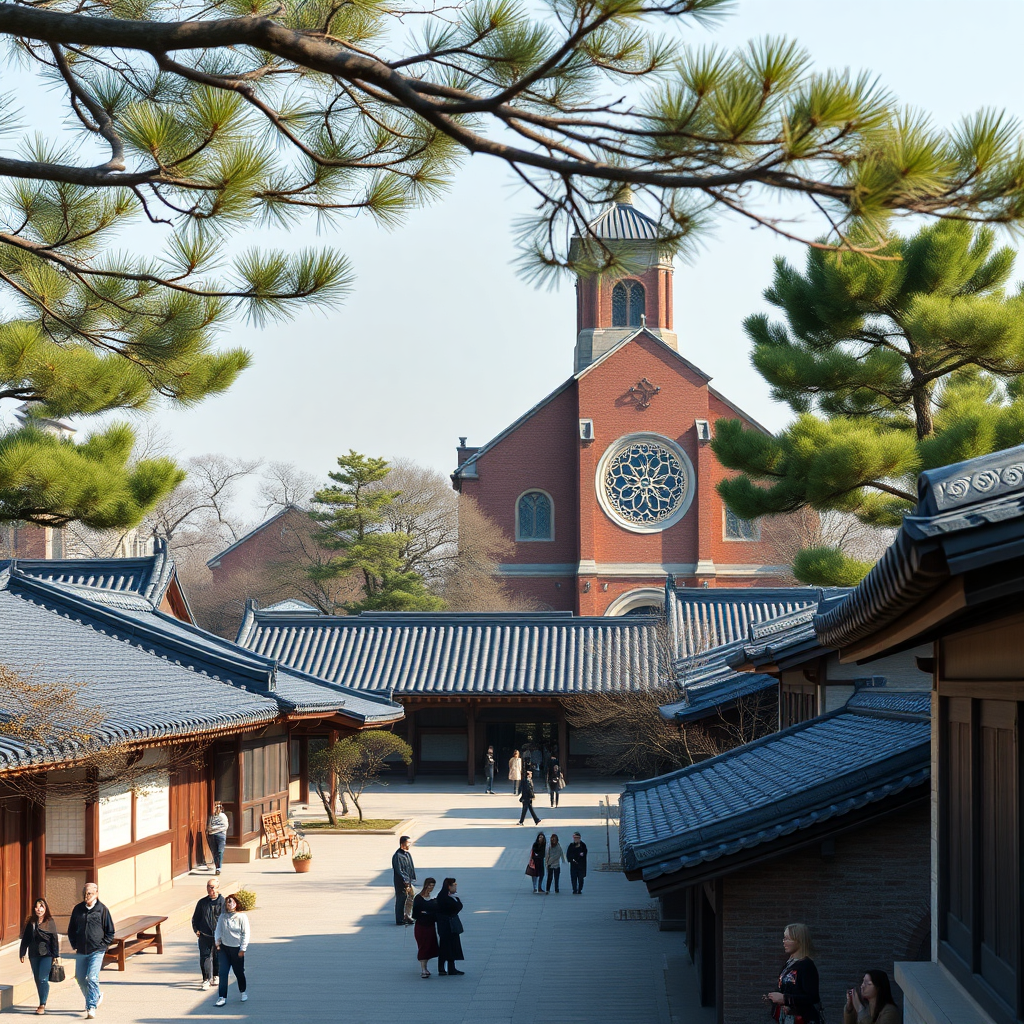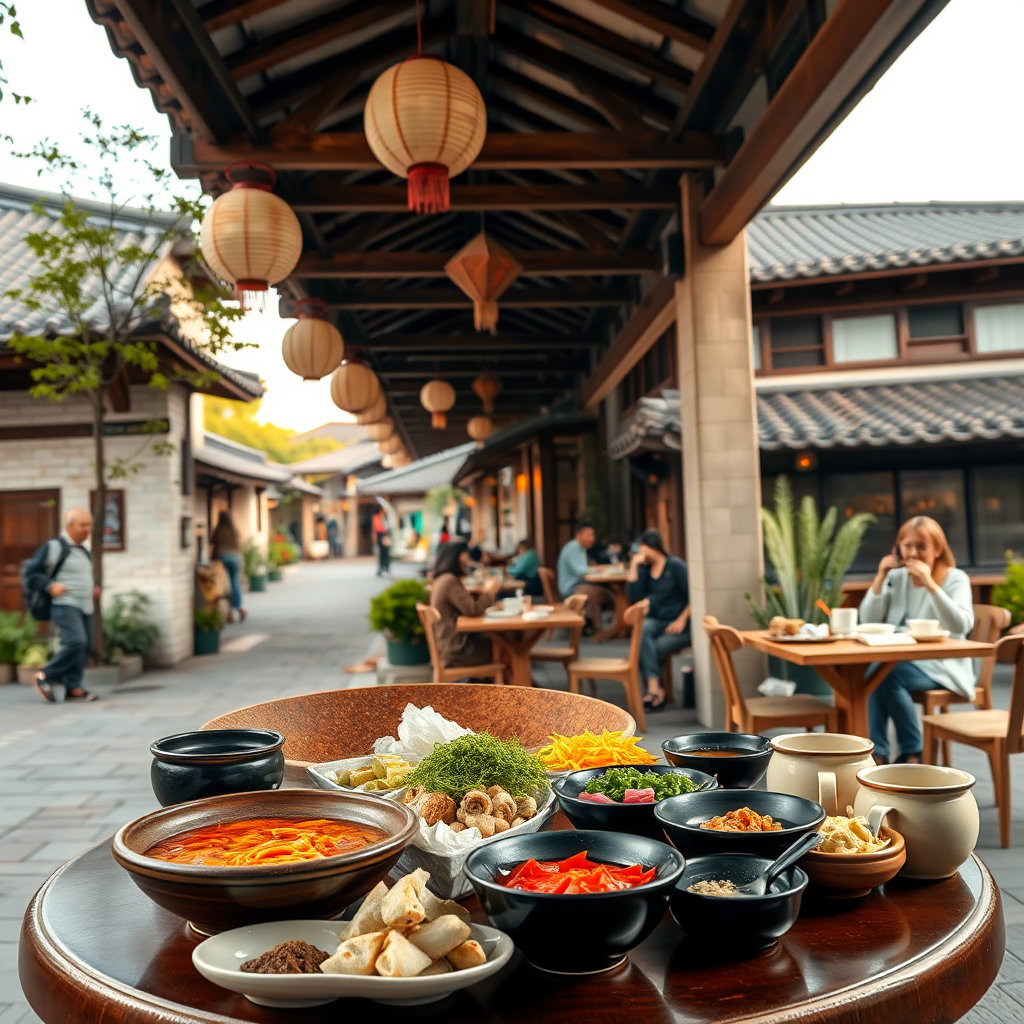Discover Jeonju Hanok Village Charm
- 공유 링크 만들기
- X
- 이메일
- 기타 앱
Welcome to the Heart of Jeonju Hanok Village
Are you ready for a journey that’s both timeless and trending? Jeonju Hanok Village invites travelers to a captivating blend of tradition, taste, and creativity. Wandering its maze of antique wooden alleys, feeling the scent of pine and the warmth of old rooftops, you’ll find yourself stepping back in time—yet surrounded by modern vibrancy. This guide is crafted for first-timers and seasoned explorers alike, providing all you need: transportation tips, unique photo spots, foodie adventures, reservation info, parking insights, and trivia to make your own unforgettable story. Don’t miss this in-depth look at Korea’s cultural heart; Jeonju Hanok Village has a spell for every kind of traveler.
Ready to be charmed? Let’s dive in!

Planning Your Jeonju Hanok Village Trip: A Step-by-Step Guide
If you want to truly enjoy the charm of Jeonju Hanok Village, a well-organized travel schedule and smart transportation choices are essential. Let's break down a practical itinerary and explore the best ways to get around, so you can make the most of your time in this beautiful, traditional Korean village.
1. Morning: Arrival & Hanok Village Exploration
Most travelers arrive at Jeonju Station or Jeonju Express Bus Terminal. From there, take a local bus or taxi to Hanok Village (about 15-20 minutes). Start your day with a stroll through the alleys lined with over 700 traditional hanok houses. Don't miss the Gyeonggijeon Shrine and Jeondong Cathedral—these are must-see spots for history and architecture lovers.
2. Lunch: Local Food Experience
Jeonju is famous for its bibimbap and street food. Around noon, visit a local restaurant or try the food stalls in the village. This is a great time to recharge and experience Jeonju's culinary culture.
3. Afternoon: Hanbok Experience & Cultural Activities
After lunch, rent a hanbok (traditional Korean dress) from one of the many shops in the village. Walking around in hanbok will make your trip more memorable and provide amazing photo opportunities. Participate in traditional craft workshops or tea ceremonies to deepen your cultural experience.
4. Evening: Night View & Return
As the sun sets, the hanok village takes on a magical atmosphere with soft lighting and quiet streets. Enjoy the night view and, if you have time, stop by a local café for dessert. Return to your accommodation or head back to the station by taxi or bus.
- Transportation Tips
- From Seoul: Take KTX (high-speed train) to Jeonju Station (about 1.5 hours), then local transport to Hanok Village.
- In Jeonju: Use local buses (frequent and affordable), taxis (convenient for groups), or even rent a bike for a unique experience.
- On Foot: The village itself is best explored on foot—most attractions are within walking distance.
| Time | Activity | Recommended Transport |
|---|---|---|
| 09:00 | Arrive at Jeonju | KTX, Express Bus |
| 10:00 | Explore Hanok Village | Local Bus, Taxi |
| 12:00 | Lunch | On Foot |
| 13:30 | Hanbok Experience | On Foot |
| 15:00 | Cultural Activities | On Foot |
| 18:00 | Night View & Return | Taxi, Local Bus |
Why Smart Planning Matters
With a well-planned schedule and knowledge of local transportation, you can avoid unnecessary stress and enjoy more of what Jeonju Hanok Village has to offer. Whether you are a solo traveler, a couple, or a family, efficient movement between attractions maximizes your experience and leaves you with unforgettable memories.
Travel Tips:
- Download a local map app before your trip.
- Check bus schedules in advance, especially for late evening returns.
- Wear comfortable shoes for walking on stone paths.
- Try to visit on weekdays to avoid crowds.
Key Insights:
- Jeonju Hanok Village is best enjoyed with a flexible yet organized itinerary.
- Public transportation is efficient and budget-friendly, but taxis offer convenience for groups or families.
- Walking is the best way to soak in the atmosphere and discover hidden gems.

Have you ever dreamed of stepping into a living, breathing piece of Korean history? Jeonju Hanok Village is the perfect place to do just that. At the heart of Jeonju, the main street of Hanok Village unfolds like a scene from a traditional painting, inviting visitors to slow down and savor every moment.
As you walk along the main street, you’ll be greeted by rows of beautifully preserved hanok houses, their curved tiled roofs and wooden beams exuding a timeless charm. The air is filled with the aroma of local street food, and the gentle hum of visitors exploring every corner.
One of the greatest joys here is discovering the many photo zones that capture the unique beauty of the village. From the iconic stone walls and narrow alleyways to vibrant murals and cozy tea houses, every spot tells a story.
Why should you explore the main street and photo zones?
- Preserved Tradition: The main street is lined with hanok houses that have stood for generations, offering a glimpse into Korea’s architectural heritage.
- Perfect Photo Opportunities: Whether you’re a professional photographer or just snapping memories with your phone, the village’s photo zones provide stunning backdrops for every shot.
- Local Experiences: Enjoy traditional snacks like choco pie and bibimbap, or try on a hanbok for a truly immersive experience.
- Relaxing Atmosphere: The blend of old and new creates a peaceful environment, perfect for a leisurely stroll or a reflective moment.
Tips for the Best Experience:
- Visit early in the morning or late afternoon for the best lighting and fewer crowds.
- Don’t miss the famous Omokdae Pavilion for panoramic views of the village.
- Wear comfortable shoes, as the stone-paved streets can be uneven.
- Be respectful of the residents who still live in the hanok houses.
Exploring Jeonju Hanok Village’s main street and photo zones is more than just sightseeing—it’s a chance to connect with Korea’s rich cultural heritage and create memories that will last a lifetime. Whether you’re seeking inspiration, relaxation, or a deeper understanding of tradition, this charming village has something for everyone.

Jeonju Hanok Village is not just a collection of beautiful traditional houses—it's a living, breathing storybook of Korean history and culture.
Two of its most iconic landmarks, Gyeonggijeon Shrine and Jeondong Catholic Church, offer a unique glimpse into the soul of Jeonju and are must-visit destinations for anyone seeking inspiration and insight.
Gyeonggijeon Shrine: Where Joseon Dynasty Lives On
Gyeonggijeon was built in 1410 to enshrine the portrait of King Taejo, the founder of the Joseon Dynasty.
As you step through its grand gate, you are immediately transported back in time. The tranquility of the pine trees, the dignified architecture, and the solemn atmosphere make it a perfect place for reflection.
Many visitors find that a walk here helps them slow down and appreciate the importance of legacy and roots.
The shrine is also a symbol of resilience, having been rebuilt after destruction during the Japanese invasions.
This history teaches us that, just like Gyeonggijeon, we too can rebuild and thrive even after hardships.
Jeondong Catholic Church: Harmony of East and West
Jeondong Catholic Church stands as a striking contrast to the traditional hanok houses nearby.
Built in 1914, its Romanesque architecture, stained glass windows, and red brick walls tell a story of cultural exchange and religious tolerance.
The church was constructed on the very site where Catholic martyrs sacrificed their lives, making it a place of deep spiritual significance.
Many people come here not only to admire its beauty but also to find peace and contemplate the value of faith and coexistence.
The church's presence in the heart of Hanok Village reminds us that diversity can create a richer, more harmonious community.
- Why Visit These Landmarks?
- They offer a window into Korea's complex history and cultural resilience.
- Both sites encourage reflection on the importance of heritage and spiritual values.
- Visiting these places can inspire you to appreciate your own roots and the diversity around you.
| Landmark | Year Built | Key Insight |
|---|---|---|
| Gyeonggijeon Shrine | 1410 | Legacy, resilience, and the value of history |
| Jeondong Catholic Church | 1914 | Diversity, harmony, and spiritual reflection |
Tip: Take a moment to sit quietly in the courtyard of either site.
Let the atmosphere inspire you to reflect on your own journey, and consider how history and diversity have shaped your life.
Jeonju Hanok Village is more than a tourist destination—it's a place where the past and present meet, offering lessons in resilience, harmony, and the beauty of cultural diversity.
Whether you're a history buff, a spiritual seeker, or simply someone looking for inspiration, the stories of Gyeonggijeon and Jeondong Catholic Church will enrich your visit and your life.

Jeonju Hanok Village is not only famous for its beautiful traditional architecture, but also for its vibrant food scene and unique cafes that blend history with modern charm.
If you want to truly experience the essence of Jeonju, exploring local restaurants and hanok-style cafes is a must.
Stage 1: The Ordinary World
Imagine arriving in Jeonju, greeted by rows of elegant hanok rooftops and the aroma of delicious food wafting through the air. The city feels both peaceful and full of anticipation.
Stage 2: The Call to Adventure
As you stroll the narrow alleys, you hear about a legendary bibimbap restaurant and a hidden hanok cafe known for its traditional desserts. Curiosity stirs within you.
Stage 3: Refusal of the Call
You hesitate—there are so many choices, and the lines are long. Is it worth the wait? Should you just settle for something quick?
Stage 4: Meeting the Mentor
A friendly local suggests, "Try the original Jeonju bibimbap at Gogung—it's a taste you won't forget. And for coffee, Gyodong Tea House offers a serene hanok experience."
Stage 5: Crossing the Threshold
Inspired, you step into Gogung. The bibimbap arrives, a vibrant bowl of fresh vegetables, marinated beef, and perfectly cooked rice. Each bite is a harmony of flavors.
Stage 6: Tests, Allies, and Enemies
After your meal, you explore more. At Hyanggyo Cafe, you sip on hand-drip coffee while gazing at the hanok courtyard. At Jeonmang, you try traditional Korean sweets with a modern twist. The challenge? Choosing where to go next!
Stage 7: The Ordeal
You brave the crowds at Nammun Market for choco pie and kongnamul gukbap (bean sprout soup). The energy of the market is exhilarating, and you realize Jeonju's food culture is an adventure in itself.
Stage 8: The Reward
As the sun sets, you relax at Cheonnyeon Hyanggi, a hanok cafe with panoramic views. Sipping tea, you reflect on your journey—every meal and cafe visit has deepened your appreciation for Jeonju's culinary and cultural richness.
Top Jeonju Restaurants & Hanok Cafes (Recommended List)
- Gogung – Authentic Jeonju Bibimbap
- Gyodong Tea House – Hanok-style tea and desserts
- Hyanggyo Cafe – Hand-drip coffee in a tranquil hanok
- Jeonmang – Modern Korean desserts with hanok views
- Nammun Market – Street food, choco pie, kongnamul gukbap
- Cheonnyeon Hyanggi – Hanok cafe with sunset views
| Place | Specialty | Atmosphere |
|---|---|---|
| Gogung | Bibimbap | Traditional, bustling |
| Gyodong Tea House | Tea, Korean desserts | Quiet, authentic hanok |
| Jeonmang | Modern desserts | Trendy, hanok fusion |
| Nammun Market | Street food | Lively, local |
Insight: Jeonju's food and cafe culture is not just about taste—it's about slowing down, savoring the moment, and connecting with Korea's rich heritage. Whether you're a foodie or a culture lover, these experiences will enrich your journey and leave lasting memories.
Keywords: Jeonju Hanok Village, 맛집, 한옥 카페, 전주 비빔밥, 전주 여행
- 공유 링크 만들기
- X
- 이메일
- 기타 앱
